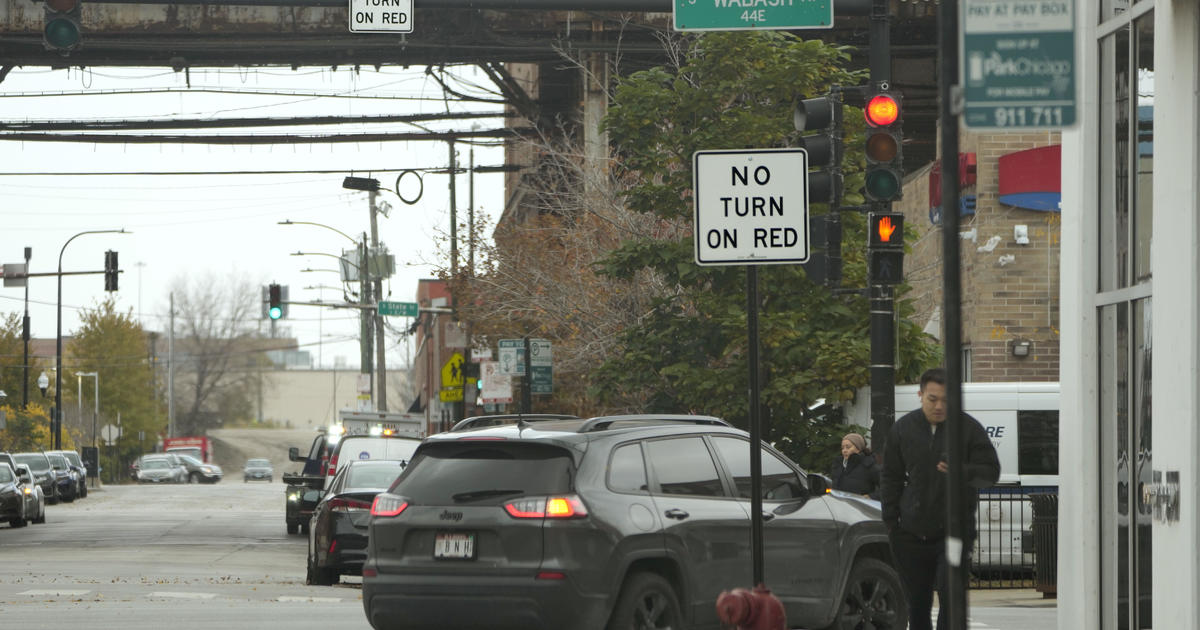Sophee Langerman was on her way to a bicycle safety rally in Chicago’s Lakeview neighborhood in June when a car turning right rolled through a red light and slammed into her bike, which she was walking off the curb and into the crosswalk.
The car was moving slowly enough that Langerman escaped serious injury, but the bicycle required extensive repairs. To Langerman, it’s another argument for ending a practice that almost all U.S. cities have embraced for decades: the legal prerogative for a driver to turn right after stopping at a red light.
A dramatic rise in accidents killing or injuring pedestrians and bicyclists has led to a myriad of policy and infrastructure changes, but moves to ban right on red have drawn some of the most intense sentiments on both sides.
Washington, D.C.'s City Council last year approved a right-on-red ban that takes effect in 2025. New Chicago Mayor Brandon Johnson’s transition plan called for “restricting right turns on red,” but his administration hasn’t provided specifics. The college town of Ann Arbor, Michigan, now prohibits right turns at red lights in the downtown area.
I live in one of these cities (Denver) and in my city’s case this push is part of a ton of other provisions including a push to set a maximum speed limit citywide of 25 mph.
About 80% of my trips out of the house are walking or on a bike, but it seems clear to me that policies like this don’t improve safety. It’s just lazy policy making. For example, if you set a 25 mph speed limit on a road designed to support 45 mph traffic, most drivers will still drive 45+ mph and you instead get a wild mismatch of driving speeds. This just slows traffic with an arguably negative benefit to safety. Similarly, if you ban turn on red in the city many drivers will still turn on red, but now whether or not a car will turn on red becomes unpredictable.
What our cities need is more dedicated bike and pedestrian infrastructure that is separated altogether from the roads, as well as greatly improved public transit.
See, the thing is, those roads that were 45mph have more than enough room for both cars and bike/ped infrastructure. The issue is that, generally, the lanes for higher speed roads are wider. Narrow the lanes and people feel they have to go slower to stay in the lines (which is true for a lot of drivers, bless their hearts). It’s an unconscious response to narrowing roadways that can be used to actually make people slow down, rather than just telling them not to. And when you narrow the lanes, that leaves more room in the same space for stuff like bike lanes and sidewalks.
Yup and I’d LOVE to see some of those four lane roads get turned into two or three lane roads with protected bike lanes
However, in a city that’s primarily optimized for cars and lacking in other forms of infrastructure, the main impact of traffic calming measures is to make it really hard to get anywhere in an efficient manner. I don’t believe it significantly improves safety, but it will undoubtedly make a lot of people who rely on their cars absolutely miserable.
The root of the problem is that we simply have too many cars on the roads to begin with. However, we can’t reasonably ask people to stop driving until the alternatives are as safe and convenient as a car. The primary focus should be on urban planning that makes walking, biking, or taking light rail an attractive alternative. In the case of walking and cycling, this overwhelmingly means dedicated infrastructure.
The root of the problem is that we simply have too many cars on the roads to begin with. However, we can’t reasonably ask people to stop driving until the alternatives are as safe and convenient as a car.
You’ve got that entirely backwards: driving must become painful in order for people to support funding alternatives.
Edit: downvote me all you like, folks, but it doesn’t change the fact that we’ve been trying to do it the other way for decades and it doesn’t fucking work.
You’re being downvoted, but that’s exactly what many europeans cities have been doing for many years now. When going into the city center by car is the worst option, people choose other ways to go.
Did those cities already have good mass transit set up to facilitate a better option, I legit don’t know? I like this plan but I wonder if it will be successful with how absolute dog shit this country’s mass transit is.
Did those cities already have good mass transit set up to facilitate a better option
Maybe, but that’s a moot point because so did cities in the US. Take some of the biggest poster-child cities for car-dependency, Atlanta and Los Angeles, for instance.
Here’s what Atlanta’s streetcar network looked like in 1924:

And here’s what LA’s streetcar network looked like in 1938:

We had good cities with public transit in the US. We didn’t build our cities – even sunbelt ones – for the car; we demolished them for the car.
One more example. Here’s downtown Houston from the 1970s:

All those parking lots used to have buildings on them.
The difference is that those cities are denser, better laid out for walkability, and have tremendously better public transport.
But if you can’t get people to support alternatives, how will you get them to support making driving more painful?
Even if the government does nothing, that’ll happen naturally over time as increasing traffic chokes itself out.
Proper mass transit. Then pedestrian and bike paths are more useful.
After that, cars can go fuck themselves.
What my city is doing is removing car lanes to replace with bike lanes, lowering the speed and also policing it and it worked to turn a 4 lane, 45mph area into a 2+turn lane, 25mph road and improved bike safety. Lowering the speed limit is the cheapest and easiest method. It will probably take a bit to claw that land from the driver’s and build something for pedestrians with it.
In NYC, right on red is illegal and I’d venture a guess that >98% of drivers obey this. Obviously each city will need to handle it differently, but they can’t make it illegal and then call it a day. Enforcement and change infrastructure to match the new rules of the road are necessary. In the case of lowering speed limits, traffic calming measures should be put in place with the reduction in speed limit, so that going 45mph in a 25mph zone is difficult.
Enforcement is the big issue. I’ll be taking pedestrian safety to my city task force next month and addressing a number of systemic issues, the biggest one of which there is zero pedestrian safety enforcement.any states and cities have absolutely great pedestrian safety laws, they are just not enforced at all. The article has some nice data points I can mention.
In Oregon, any interestion, marled or unmarked is a crosswalk and drivers must stop. Of course they don’t and get aggressive or just drive past you when you try to cross in 30+ roads. If we enforced pedestrian safety for existing laws with 10% of the effort we put into enforcement of other crimes the culture could change.
When you add cycle paths turnijg right on red needs to be gone. If the cars can’t turn it is usually time for cyclists to cross.
Disagree. I spent all of my 20s living the no car lifestyle and cycling 100-200 miles a week on city streets. I have had countless negative interactions with cars but not a single one had anything to do with right turns on red.
I just don’t see any meaningful safety improvement from it but significant downsides in terms of traffic flow.
There are countries where right turn on red is prohibited and it makes no problems with traffic flow. Also, change is possible, people are able to get used to new rules.
In my country, besides right on red being illegal (having never been legal), traffic lights themselves are seen as a thing of the past and most of them were replaced with roundabouts decades ago.
Sounds civilized.
I find this really hard to believe. Probably once a day I have to deal with some dipshit not looking for bikes coming down the bike lane before turning right.
Maybe you biked in the car lane, which is fine, but that doesn’t mean those of us in the bike lane don’t have to deal with this constant danger.
Weird I had a car in my 20s and still had multiple right turn on red incidents as a pedestrian. Crazy how our narrow perspectives aren’t the full picture.
I have… Was on a poorly designed bike lane where the straight bike lane & right turn lane merged at the intersections. I stopped at the red light waiting for the light to turn green (as your supposed to do).
A car pulled in behind me and immediately started honking and putting his head out the window to berate me for blocking his right turn on red. I was actually terrified & was one of the interactions that made me reconsider using my bike as transportation.
Sorry that happened to you. I have had similar experiences, I have had people literally hit me with their cars because they’re angry I’m taking the lane, bad things thrown at me from moving vehicles.
However, I don’t see experiences like yours as being caused by the right turn law so much as the constant fact that people on cars sharing roads with bikes are assholes.
I will say, as a cyclist the polite thing to do is to position your bike to let turn-on-red people past you whenever possible. I don’t think it justifies this guys behavior and don’t know what this intersection looks like but it’s worth bringing up.
To counter your anecdotal evidence, I have nearly been hit several times because cars can turn right on red. I have had the cycle lane or sidewalk blocked because of it. And any time I’m wanting to cross, I’m fearing a car will show up and hit me before I’m out of the way.
My first bad interaction as a cyclist was from a right turn on red.
My bike got crushed, and I was told it was my fault since I was on the sidewalk (The alternative would be to share the actual lane with cars in the highway, with no room for the bike. There was no bike lane.). 20yo me was devastated to lose my only means of transportation, I didn’t have the ability to get a new bike, so I had to walk instead, this was annoying/frustrating enough to stick with me…
You see how anecdotes aren’t necessarily ways to determine this? Everyone will have different ones.
I mean, that’s a large part of why it’s illegal to ride a bike on the sidewalk and every major bicycle safety advocacy group says to take to the road. It’s pretty well understood that riding on the sidewalk is incredibly dangerous because it’s very difficult to see a fast moving bike when it’s off the road.
If it wasn’t a turn on red it would have been someone turning right into a driveway eventually.
The alternative would be to share the actual lane with cars in the highway, with no room for the bike. There was no bike lane.
Yes this is exactly what you should be doing as a cyclist if you want to be safe and seen. If there isn’t a bike lane you take the entire lane like a car. I have ridden many thousands of miles like this. Even when there is a bike lane it’s often the safest option if the bike lane is in poor condition.
The reason I advocate so hard for dedicated infrastructure is because I want to see more people biking and many people have a hard time feeling comfortable riding in the street. I get that. But in this case it’s the fault of the cyclist for failing to follow the rules of the road.
I live in Seattle. We implemented the 25mph rule and it does seem to actually be helping. This is after a lot of attempts at improving pedestrian safety failed to have any effect. It’s irritating because it seems like it takes forever to drive anywhere in this city, and there are definitely a lot of corners cut in infrastructure that could improve safety—including very simple things like adding more marked crosswalks and stop signs at uncontrolled intersections—so I consider it a mixed bag overall.
I agree for the most part. It’s better to design streets so that drivers feel uncomfortable at higher speeds. Street narrowing, bollards, trees, smaller set backs can all slow cars down.
That said, as a counterpoint, despite similar street design, the speed limit in most of Canada is 50kmh (30 mph) and many urban residential streets are down to 30km (18.6 mph). Some people speed, but driving 45 mph (72 km/h!) down most city streets is pretty rare. Pedestrian and cycling accidents involving cars in Canada are close to half the rate of the US. Which is to say, I don’t think the Denver mayor’s proposal is crazy. It works in Canada, but it will take time for the culture to change.
I think the focus here really needs to be on supporting alternative forms of transport.
We have a city that’s already filled with gridlock almost 24/7, even at 2am in the evening. The city planning is such that it’s hard to go significant distances without a car without spending hours in transit. If the primary lever for change is to institute slower speed limits and traffic calming measures, it simply makes things miserable for everyone involved.
IMO the root of the issue is we have way too many cars and not enough alternative infrastructure to make going without a car especially practical.
Denverites love to walk and bike when it’s convenient and they feel safe. I firmly believe that dedicated infrastructure would dramatically reduce the number of car trips as well as give structural safety measures walkers and cyclists. This would reduce deaths while making the city a more pleasant and healthy place to be. Thats why it should be the primary focus in terms of change.
I agree with everything you said in the second half. Better non-car infrastructure should be the primary focus!
But I don’t see why traffic calming and slower car speeds would make things miserable for “everyone”, like cyclists or pedestrians. I wouldn’t ride my bike nearly as often if cars could go 45 mph on Canadian streets. Making cars uncomfortable is part of encouraging other modes of transportation.
There are many reasons why it is bad for everyone, but I will cite a few specifics.
To start with, in the absence of good alternatives, vast majority of pedestrians and cyclists would also be regular drivers. The only exceptions would be people who are too poor to avoid a car. If the drivers and the walkers are the same people then the people who regularly walk still suffer from slowed traffic because they still take the car for some trips.
Poor mobility for cars also translates to increased cost of living. Most businesses rely upon vehicle transport in some way or another and the increased cost of doing business gets passed onto the consumer.
In addition, the existence of high throughput streets with higher speed limits tends to concentrate traffic into specific predictable areas. When you reduce the throughput of those areas, traffic gets distributed onto more roads. The result is that cyclists and pedestrians are less able to avoid cars with strategic route planning.
I wouldn’t ride my bike nearly as often if cars could go 45 mph on Canadian streets.
To clarify, this isn’t every street in the USA, it’s only major thoroughfares. Most side streets in US cities have a 25-30 mph speed limit. In a world with well designed bike infrastructure we would have dedicated paths separated from traffic so you don’t have to share the road with fast moving cars.
Poor mobility for cars also translates to increased cost of living.
Nope, that’s backwards. Poor mobility for cars comes from higher-density development, which is also efficient development because you don’t have to spend huge amounts of money building parking. Getting rid of the cars is the thing that lowers the costs!
Futhermore, getting rid of the cars is also the thing that enables walking/biking/transit to be viable (because there’s physically less distance to cover, since you don’t have to cross a wasteland of pavement), which also lowers cost of living.
The bottom line is that if you build to accommodate cars, you will never have walkability. It’s geometrically impossible.
When you reduce the throughput of those areas, traffic gets distributed onto more roads. The result is that cyclists and pedestrians are less able to avoid cars with strategic route planning.
Distributing traffic onto more (uniformly-slow) streets means that cyclists and pedestrians have less need to avoid cars with strategic route planning because slow-moving cars aren’t nearly as much of a danger to begin with.
Did you actually read anything I have written?
The point is that simply lowering speed limits as the primary lever to improve quality of life isn’t useful. It does nothing to reallocate that space in a beneficial way.
I’m literally arguing in favor of reducing space for cars for more pedestrian, cycling and transit infrastructure
The bottom line is that if you build to accommodate cars, you will never have walkability. It’s geometrically impossible.
Guess what? The city is already built. I agree with you.
The question is how to move forward and slapping lower speed limits on everything isn’t the solution. You need to actually spend money on revamping the infrastructure so there are meaningful alternatives. Try to read more and jump to conclusions less.
I’m literally arguing in favor of reducing space for cars for more pedestrian, cycling and transit infrastructure
You’re literally arguing for going about it ass-backwards in a way doomed to failure, which is a disingenuous, passive-aggressive way of opposing it.
You need to actually spend money on revamping the infrastructure so there are meaningful alternatives.
In order to actually spend money on bike/ped/transit, the politicians have to allocate it for that purpose. That doesn’t happen unless the public is made to hate driving first!
I’m sorry but most of what you say doesn’t make any sense. Why would making it easier and faster to drive encourage cycling and walking?
Let me address your points in turn:
-
Yes, slowing car traffic makes car travel worse. That’s the point. Cars are massively prioritized right now.
-
Cars are a cost of living disaster. The US and Canada spend the most on transportation costs in the world. The US actually spends more public tax dollars on transportation because car infrastructure is the least efficient and most expensive to build. Cars themselves are the biggest household expense after housing. Businesses also thrive in car free environments. In Europe, businesses know this and fight to remove car infrastructure. Ever wonder why the most economically vibrant areas are the least car dependent? The US and Canada are brainwashed.
-
The solution to cars driving on cycling routes is to lower the speed limit even more on those routes. Like I said, in Canada many cycling routes are 18 mph. Most drivers go even slower on cycling prioritized routes. It’s mind boggling to think it would be safer if cars could go faster.
-
I’ve lived for many years in both countries. The US drives way faster and is much more dangerous, despite similar looking streets. In most other developed countries, traffic accident rates are falling to record lows. The US is a tragic outlier.. Prioritizing “traffic flow” is the heart of the problem.
-
More infrastructure for cars = even more cars on the road, as simple as that.
You want to fix a gridlocked city with awful traffic? You start taking lanes out and making them exclusive for public transport, and you build big sidewalks and a cycling lane. Now you can get where you want to go in 10 minutes using public transport or bike, or you can sat in traffic for an hour - magically, you’ll see traffic getting better and less cars on the road.
It’s not as if this is some mistery - it has been done in many cities around the world and it works. The alternative is the american way, “just add one more lane”, and you guys live with the results.
I think there’s a lack of understanding on just how differently American and European cities are structured. Unless you’re in the Northeast, cities aren’t densely packed. They’re broad and sprawling. This is especially true of mid sized cities. Housing is typically far from businesses. A 10 minute bike ride would barely get me out of the neighborhood, and I’d still have aways to go before a major road.
On the other hand, I biked around campus in college and took the bus system all the time. I didn’t need a car for my day to day.
Public transit is a real challenge for us. There’s no easy answer. Our cities just aren’t structured for it. And I don’t think there’s a public transit model yet that could totally replace cars for us.
I live in Denver too and couldn’t agree more.
Similarly, if you ban turn on red in the city many drivers will still turn on red, but now whether or not a car will turn on red becomes unpredictable.
Put up traffic cameras and ban those ignoring the red light light from driving for a month. You know, just like it’s done in other countries already.
I think all that would accomplish is getting a lot of working class people fired who are living paycheck to paycheck. Other countries have much better public transit.
They take your license just for running a red light? In many parts of America that would leave you unable to satisfy basic necessities like getting to work and buying groceries. It’s frankly ridiculous.
Guess I’m glad I live in the good ole USA
Not to mention, running a red isn’t usually a willful thing, but a “shit can I get through this yellow light?” And there’s always that uncomfortable of grey area on if you should slam your breaks or speed up.
There’s only a fine for running a red light when the light has been red for less than one second.
Glad to live in a country where people don’t run red lights nearly as commonly. Speeding is still far too common though, here’s hoping we get to implement the Danish model where extremely reckless driving will lead to the car you’re driving being confiscated and sold.
Yeah just like Oklahoma tried to ban driving through a yellow light they had to repeal that shit fast.
Cities cant suddenly change the turn on red when we were all taught we can. And if any city made the entire city 25mph I would avoid it like the plague and most companies that deliver good like truck drivers would either ignore it or boycott your town. Good luck with your supply chain issues.
I’m totally down for this. Right turn on red is optional, but people behind me seem to think it’s required and lay on their horns if I stop for more than a second. Like come on, I need a moment to make sure someone isn’t trying to cross!
I’m in favor of prioritizing safety, but if right on red is permitted, then it’s not optional. Just like going on green is not optional. Once you determine that you have the right of way you are expected to take it. This makes you predictable and safe.
Other drivers should be giving you a reasonable amount of time to determine your right of way though. You are also supposed to come to a full stop which should technically take about 3 seconds.
Right on red is most definitely optional. No need to be “predictable” in this situation - you’re coming to a full stop no matter what. How is not moving again unpredictable?
I’ve never heard of such a requirement. Where is that?
Here in Massachusetts, the law (MGL ch 89 sec 8) says: “At any intersection in which vehicular traffic is facing a steady red signal, the driver of a vehicle may make a right turn” (summarized, emphasis mine). May, not shall.
I read the full section, which is about right of way. It is consist with my prior statement. The summary you provided is the one that states that drivers have the right of way on red lights under certain conditions.
You’re framing this as if the people behind you are in any way involved in your decision to make a right on a red. You’re also saying its not optional, which is just blatantly incorrect.
When turning right on red, you get to decide when is safe, not the people behind you. You are not required to turn because that would be a massive safety hazard because people would feel rushed into prevailing traffic, and objectively deciding when a turn was safe to execute is hard when you feel rushed. Being rushed makes everyone less safe, especially pedestrians, because you are distracted. Distracted.
You do not know how responsive their car is, you do not know how comfortable they are full sending it, and you probably cannot see the road as well as they do. This is why when they go is not your decision.
What a beyond stupid take, you are lucky you live somewhere where you are allowed to have your license even though you clearly cannot drive.
Hoonnnkk honnnnkk hooonnnk you go as the person in front of you has a ped crossing in front of them you can’t see.
Hoooonnnkk honnnkk honnnnkk you go as there’s a small gap, but the person in front of you is driving with their mom recovering from surgery, in pain and feeling carsick.
Hooonnkkk honnnkk honnnk you go as a mother is being screamed at by her kids and is trying to get a small moment of rest at the red light, slightly delaying their turn.
You’re a self absorbed dumbass.
You didn’t understand anything I said.
Sure, and it has nothing to do with the big ass vehicles being churned out due to loopholes in US law.
https://www.distilled.earth/p/the-loophole-that-made-cars-in-america
Just freaken yesterday I was walking with my kids and there was a sports utility bullshit parked ready to come out of the garage and as we passed I noted that not one of my kids is tall enough to be seen by the driver if they decide to move forward.
A sports utility truck is a truck not a car. Require a CDL to operate or better yet just buy a regular car.
“What’s really behind this movement is part of the agenda to make driving as miserable and as difficult as possible so people don’t drive so much,” Beeber said.
This is an unbelievably idiotic statement, as if cars haven’t been, and don’t continue to be nearly the sole consideration for transportation in almost all American cities.
deleted by creator
Or better yet, give cyclists sperated spaces from cars and trucks to ride. Even if it’s just letting them ride on sidewalks. (Although not applicable in this case)
I always thought pedestrian crossings should be further back from the intersection. With them being a part of the intersection itself you have to deal with traffic and pedestrians changing positions at the same time vs just traffic or just pedestrians crossing the street.
That, and also because NYC has already banned right on red.
“What’s really behind this movement is part of the agenda to make driving as miserable and as difficult as possible so people don’t drive so much,” Beeber said.
Shit. He figured my plan out.
But seriously people driving less would be a win. Cars are awful.
As someone who went to the US recently and nearly got taken out by a driver rolling right through the crosswalk only looking to her left, get rid of right turn on red. We survive just fine without it (well, it would technically be a left turn here) in Japan.
In the Netherlands it wouldn’t even work as yhere are usually cycle paths or pedestrian crossings that have a green light. Right turns have their own light whenever possible to make sure they are on their own cycle.
It’s the size of the cars that’s causing the increase.
Wow, you are totally right.
SUVs and pickup trucks do not have to follow the safety regulations of passenger cars.
Passenger cars have rounded pedestrian safe bumpers that are designed to scoop under a pedestrian in a collision, resulting in injuries that are likely to be survivable.
Modern pickup trucks have massive flat grills directly at chest height, which act as a battering ram, and will roll over a pedestrian in a collision, resulting in injuries that are unlikely to be survivable. Pickup trucks and SUVs have large front blind spots that make them more likely to cause collisions than normal cars.
The increasing numbers of pedestrian fatalities is caused by the increasing number and size of pickup trucks and SUVs. This will only change if the feds close the loopholes that allow SUVs to not follow the same regulations as cars.
I think it’s a visibility thing too. Also many distracted drivers.
I mean, it’s pretty easy to not hit someone while turning right on red if you look where you’re going…
In a lot of cities, it’s extremely difficult to see past the corner because of parked cars. We could cut down on street parking, but people scream if you even consider restricting their parking options.
Especially when those parked vehicles are trucks or SUVs or some other unsafe large vehicle.
I mean I have a hate boner for giant cars as much the average person, but even a reasonably-sized, economy sedan can block my view of the sidewalk/any cars that might be coming around the corner. I would say it’s a 50% chance in my city that, in order to safely turn right on red, I’d need to inch about halfway into the lane I’m turning into, which already has the potential of causing an accident.
The spike, which included all accidents — not just those involving right turns on red, was attributed in part to an increase in larger vehicles such as SUVs and pickup trucks on the road … due to larger blind spots and the deadlier force associated with heavier models.
There it is, this is just one reason why ‘no right turns’ will be a useless half measure, politicians trying to make it look like they’re doing something about the problem because the real solution would be too politically risky.
When I visited the US I was shocked that’s actually allowed. Seemed like a very easy way to kill someone
It’s the “cars above all” mentality.
That said my city is doing this for bicycles which is way more reasonable.
I couldn’t work out how you were supposed to negotiate it as a pedestrian, and assumed there must be some knack that locals learn. Guess the knack is just, don’t be a pedestrian lol.
My own anecdotal evidence, walking several blocks and crossing a busy intersection everyday.
I take attempts to not get hit by looking at the driver and checking to see if they are paying attention. Often a driver will inch forward until they can time turning between cars coming from the opposite side of the intersection or will turn immediately when the light changes. I often have people who wait, but mostly people will just drive past me while I stand waiting to cross.
Car size doesn’t seem to make any difference in how aware the driver is or if they are following driver safety, at least when I’m attempting to keep myself from being hit.
It less serious than this but on my drive home there is this spot with 4 car lengths between stop lights and people with trailers keep taking it as free right to get into the middle of 3 northbound lanes blocking off the far right lane for turning right at the next light
deleted by creator
If there isn’t other cross traffic, I’m going no matter what. In MA, we can even take a left on red onto a one way.
Huge majority of lighted intesections could be replaced with roundabouts/rotaries/traffic circles. Cars should not have to sit at idle if nothing is in the way.














